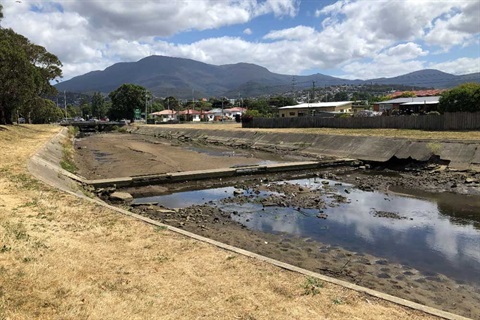New Town Rivulet Estuary Restoration Project

The City of Hobart, in partnership with Glenorchy City Council, has successfully completed the New Town Rivulet Restoration Project, returning the heavily concreted outlet to a natural, estuarine environment.
Why is this project important?
- The concrete embankment walls were up to 60 years old and beginning to degrade, risking bank erosion.
- Rewilding the rivulet will help bring back native waterbirds, aquatic life and create a beautiful natural area for residents. We have replaced the concrete walls with bouldering and other natural materials. We have also stabilised the embankments with native plants.
- The project has formalise parking and walking tracks to improve accessibility and amenity.
- Native plants and landscaping will help trap sediment and historical contamination of river beds.
What to expect from this project
The current weir remains. Its structure has been improved to help prevent sediment build-up at the rivulet mouth.
Excavated materials have been managed in an environmentally sustainable manner. They have been re-used for landscaping near the rivulet mouth. A new maintenance access ramp off Marine Esplanade will allow for the regular removal of accumulated sediment.
This project will:
- benefit local birdlife
- improve estuarine health in the River Derwent
- create a beautiful recreational area for residents.
The plans were updated following feedback from the community. This included suggestions to widen new gravel paths to ensure they are accessible for people of all abilities.
Native plantings
The project involved major earthworks and landscaping. We have planted 30 000 native trees, shrubs, water plants and grasses.
More than 30 different native species were planted as part of this project, including Tasmanian blue gums, white gums, silver banksia and Tasmanian flax-lily.
Nearly half the plants used onsite have been grown and cared for by our own nursery team.
We have collected local seeds of the rare plant species sea clubsedge. We are growing them into tube stock specially for this project.
This is one of, if not the largest, tree planting initiatives we have ever undertaken.
Background
The community provided feedback on the draft designs for this project through the Your Say Hobart website.
The project builds on a concept described in the New Town Rivulet Sediment Weir Removal Feasibility Report. This was prepared by Dryside Engineering in October 2021, and complements the 2009 Selfs Point Masterplan.
The project consisted of two distinct phases:
Stage one: Design, investigations, approvals and stakeholder relations.
Stage two: Construction of the approved design solution.
Extensive site investigations were conducted as part of stage one, including:
- detailed site survey
- geotechnical assessment of site stability
- assessment of legacy contamination from past land management practice
- flora and fauna assessments, including arboreal assessment of existing mature trees.
Stage two was the the construction phase. It involved some disruption to public access of the area. Surrounding residents and organisations were kept informed of project developments.
Gallery
Location
Marine Esplanade, New Town 7008 View Map
-42.8485812,147.314255
Marine Esplanade ,
New Town 7008
Marine Esplanade ,
New Town 7008
New Town Rivulet Estuary Restoration Project